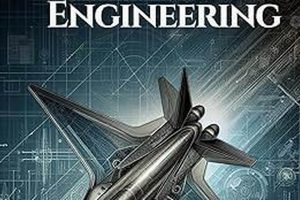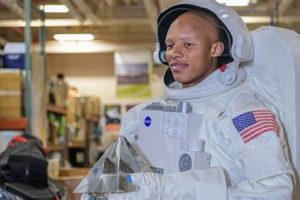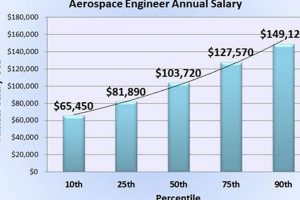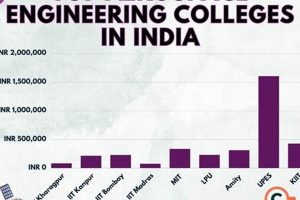Practical engagement in the field of designing, developing, and testing aircraft and spacecraft is a vital component of professional preparation. This involves applying theoretical knowledge to real-world challenges, often through internships, co-op programs, or research assistantships. For example, participating in the development of a new satellite propulsion system or contributing to the aerodynamic analysis of a next-generation aircraft are instances of such practical application.
The significance of applied learning stems from its ability to bridge the gap between academic studies and the demands of the industry. Exposure to industry practices cultivates essential skills such as problem-solving, teamwork, and communication, while also providing valuable networking opportunities. Historically, structured programs integrating practical learning have consistently produced more effective and adaptable engineers.
The subsequent discussion will elaborate on strategies for obtaining pertinent opportunities, detailing the types of roles available, and outlining how to maximize the benefits derived from these professional engagements to enhance career prospects in the aerospace sector.
Maximizing the Value of Practical Application
Gaining practical experience in the aerospace sector is crucial for career advancement. The following tips outline how to effectively secure and leverage these opportunities.
Tip 1: Prioritize Relevant Projects: Engage in academic projects that simulate real-world aerospace challenges. Examples include designing a drone, analyzing the structural integrity of a wing, or developing a control system for a small satellite. These projects demonstrate practical skills to potential employers.
Tip 2: Seek Out Internships: Actively pursue internship opportunities with aerospace companies and research institutions. Internships provide direct exposure to industry practices and workflows, enhancing understanding of engineering principles in a professional setting.
Tip 3: Network Strategically: Attend industry conferences, career fairs, and networking events. Engage with professionals, inquire about their experiences, and establish connections for potential mentorship and future employment prospects.
Tip 4: Cultivate Technical Proficiency: Develop expertise in relevant software and tools used in the aerospace industry, such as CAD software (e.g., CATIA, SolidWorks), simulation tools (e.g., ANSYS, MATLAB), and programming languages (e.g., Python, C++). Demonstrable technical skills enhance employability.
Tip 5: Document and Showcase Achievements: Maintain a detailed portfolio that highlights projects, internships, and relevant skills. Quantify accomplishments whenever possible. This portfolio serves as a tangible representation of practical capabilities during the job application process.
Tip 6: Consider Research Opportunities: Participate in research projects under the guidance of faculty or experienced researchers. These experiences offer opportunities to contribute to cutting-edge research and develop advanced technical skills.
Tip 7: Tailor Applications: Customize resumes and cover letters to align with the specific requirements of each job application. Highlight relevant skills and experiences that directly address the needs of the employer.
These strategies facilitate the acquisition and effective utilization of applied experience, strengthening a candidate’s qualifications and competitiveness within the aerospace job market.
The subsequent section will address common challenges encountered during the acquisition of such experiences and provide strategies for overcoming them.
1. Skill Development
Practical engagement in aerospace engineering projects and roles directly cultivates and refines essential skills required for professional success. The ability to apply theoretical knowledge to real-world problems, effectively collaborate within a team, and critically analyze complex systems are all significantly enhanced through practical application.
- Technical Proficiency
Hands-on involvement with aerospace-specific tools, software, and equipment directly translates to enhanced technical abilities. For example, operating wind tunnels, utilizing CAD/CAM software for design, or implementing control systems for drones solidifies theoretical understanding and provides practical competency. This proficiency allows for more effective contributions to engineering tasks and innovative problem-solving.
- Problem-Solving Aptitude
Encountering real-world challenges within the aerospace domain demands the application of critical thinking and analytical skills to identify and resolve issues. Whether troubleshooting a propulsion system malfunction or optimizing the aerodynamic performance of an aircraft, practical problem-solving experience fosters a more proactive and resourceful approach to engineering challenges.
- Teamwork and Collaboration
Most aerospace projects are collaborative endeavors, requiring effective communication, coordination, and shared responsibility among team members. Contributing to a design team, participating in group research, or working on a project alongside other engineers improves interpersonal skills, enhances the ability to work effectively in diverse teams, and promotes shared knowledge and problem-solving.
- Project Management and Organization
Participating in aerospace projects involves planning, executing, and managing tasks within defined timelines and resource constraints. Exposure to project management principles and practices improves organizational skills, enhances the ability to prioritize tasks, and ensures that projects are completed efficiently and effectively. This skill is crucial for leading and contributing to complex engineering initiatives.
These skill enhancements, derived from practical involvement in the aerospace sector, directly contribute to a more competent and adaptable engineering workforce. By integrating practical learning with academic study, prospective aerospace engineers are better prepared to meet the demands of the industry, contribute meaningfully to innovation, and achieve career success. These components are fundamental and essential towards advancing an engineering degree.
2. Industry Knowledge
Practical engagement in the aerospace sector is fundamentally linked to the acquisition of critical industry knowledge. Exposure to real-world projects, processes, and challenges within organizations involved in aerospace engineering directly contributes to a comprehensive understanding of the industry’s inner workings. This knowledge extends beyond theoretical concepts learned in academic settings, encompassing an awareness of practical constraints, regulatory requirements, market dynamics, and evolving technological trends. For example, working on a commercial aircraft design project provides insight into certification processes, manufacturing considerations, and the competitive landscape of the aviation industry. Similarly, involvement in satellite development exposes engineers to the intricacies of space law, launch procedures, and the operational realities of space-based systems.
The practical application of skills within relevant roles serves as a catalyst for deeper industry understanding. Participating in research and development, quality assurance, or manufacturing operations allows engineers to witness firsthand the impact of design decisions, the importance of system integration, and the challenges associated with maintaining safety and reliability. Consider an engineer involved in testing a new composite material for aircraft wings. Through this endeavor, the engineer not only assesses the material’s performance but also gains valuable insights into the manufacturing processes, regulatory standards, and lifecycle considerations that affect the material’s adoption in the aerospace industry. Without applied experiences, it’s difficult to get more knowledgable in this industry.
In summary, hands-on experience serves as a critical conduit for acquiring essential industry knowledge. The practical engagement with systems and processes within aerospace organizations allows engineers to understand the complexities of the sector. This understanding is critical for making informed design decisions, adapting to evolving technological landscapes, and ultimately contributing to the innovation and advancement of the aerospace field. The integration of applied learning and theoretical concepts prepares engineers for successful and impactful careers in this dynamic sector.
3. Networking Opportunities
Practical exposure in the field directly fosters networking opportunities. Participation in internships, research projects, or co-op programs inherently involves interaction with professionals, mentors, and peers within the aerospace community. These interactions facilitate the establishment of relationships that can prove invaluable throughout a career. For example, an intern working on a satellite communication system might connect with experienced engineers who provide guidance, share insights into industry best practices, and potentially offer future employment opportunities. A graduate student involved in wind tunnel testing might engage with faculty members and researchers, expanding their professional network and gaining access to academic or industrial collaborations.
Networking extends beyond formal settings such as conferences or career fairs. Regular interaction with colleagues, supervisors, and other industry professionals during typical daily activities can lead to significant career advancements. Informal conversations, project collaborations, and shared problem-solving experiences cultivate a sense of camaraderie and build trust, creating a foundation for long-term professional relationships. For instance, a junior engineer who consistently demonstrates strong teamwork and communication skills is more likely to be recognized and recommended by senior engineers for promotions or specialized training programs. Effective networking enhances career trajectory in ways that cannot be attained through technical skills alone.
The cultivation of a professional network represents an ongoing process that requires active engagement and genuine interest in the aerospace community. Maintaining connections, attending industry events, and participating in professional organizations are strategies that contribute to the sustained growth of a network. The ability to leverage these connections for mentorship, job opportunities, or collaborative research projects is a tangible benefit of practical involvement. The initial applied experience serves as a gateway, while continuous networking amplifies the long-term career advantages.
4. Problem Solving
Practical engagement in aerospace engineering provides engineers with direct exposure to multifaceted challenges that demand effective problem-solving. This experiential learning fosters a deeper understanding of the engineering process, transforming theoretical knowledge into practical expertise. The cause-and-effect relationship is evident: exposure to real-world complexities necessitates the development and application of robust problem-solving skills, which then enhance an engineer’s capacity to address future challenges. Consider the instance of designing a heat shield for a spacecraft; engineers must identify and mitigate potential issues related to material properties, aerodynamic forces, and thermal management to ensure the vehicle’s safe re-entry. Success hinges on the ability to define the problem accurately, generate and evaluate potential solutions, and implement the optimal design, all skills honed through relevant practical exposure.
The significance of problem-solving within the field is underscored by its essential role in innovation, safety, and efficiency. Engineers must routinely confront complex issues that span from optimizing fuel consumption to ensuring structural integrity. Applied experience provides the context needed to understand the practical implications of design choices and their potential impact on system performance. As an example, engineers may need to troubleshoot unexpected vibrations in an aircraft wing. By systematically analyzing data from sensors, conducting simulations, and performing physical tests, they can identify the root cause and implement corrective measures. This iterative process of problem-solving, driven by experiential insights, is crucial for advancing the field. The ability to troubleshoot and resolve these issues efficiently contributes directly to improved system performance and reduced operational costs.
In summary, applied experience offers a foundation for developing and refining problem-solving capabilities. It allows engineers to bridge the gap between theory and practice, enabling them to tackle complex issues with greater confidence and effectiveness. Continuous exposure to real-world aerospace scenarios hones the skills required to identify challenges, develop innovative solutions, and contribute to the overall advancement of the sector. The practical significance of this understanding lies in the creation of more resilient and capable aerospace systems, promoting safety, and driving future advancements.
5. Project Management
Project management, within the framework of the field, is not merely an ancillary skill but an integral component. Practical involvement in the sector necessitates consistent exposure to project management principles and practices. Aerospace projects, by their nature, are complex undertakings characterized by substantial budgets, stringent timelines, and rigorous performance requirements. These attributes mandate that engineers possess a firm grasp of project planning, execution, monitoring, and control. For example, the development of a new satellite launch vehicle demands meticulous coordination among diverse engineering teams, suppliers, and regulatory agencies. Effective project management ensures that the project remains on schedule, within budget, and adheres to all applicable safety and regulatory standards.
The application of project management methodologies such as Agile or Waterfall, within applied scenarios, equips engineers with the tools necessary to navigate the inherent challenges of aerospace projects. These methodologies provide a structured approach to task delegation, resource allocation, risk mitigation, and communication. Engineers engaged in the design and construction of a new aircraft wing, for example, must manage a complex web of tasks, involving structural analysis, materials testing, manufacturing process development, and quality control. Proficiency in project management enables the engineer to oversee these tasks effectively, ensuring that each stage of the project is completed according to specifications and within allocated resources. This enhances overall project success and mitigates potential cost overruns or delays.
In conclusion, project management is intrinsically intertwined with practical experience in aerospace engineering. The ability to effectively manage projects is not only a valuable asset but also a fundamental requirement for success. Through the application of project management principles, engineers can navigate the complexities of aerospace projects, contribute to innovation, and drive the advancement of the field. The understanding and application of these concepts result in enhanced efficiency, reduced risk, and improved project outcomes.
6. Technical Application
Technical application forms the cornerstone of competence, providing the practical dimension necessary for validating theoretical knowledge and building proficiency in the domain.
- Software Proficiency
Proficiency in industry-standard software is vital for aerospace engineers. For instance, computational fluid dynamics (CFD) software such as ANSYS Fluent allows for the simulation and analysis of airflow around aircraft wings. Similarly, CAD software like CATIA is crucial for designing components and systems. Technical application involves using these tools to solve real-world engineering problems, enhancing an engineer’s ability to design, analyze, and optimize aerospace systems.
- Hands-on Experimentation
Experimentation is critical for validating theoretical models and designs. Examples include wind tunnel testing to measure aerodynamic performance, structural testing to assess material strength, and propulsion system testing to evaluate engine efficiency. This hands-on process refines an engineer’s understanding of physical phenomena, improving their capability to design safer and more efficient aerospace systems.
- System Integration
System integration involves combining individual components into a cohesive functioning system. Technical application entails integrating software, hardware, and other elements to create an operational aerospace system. Examples include integrating avionics systems in aircraft, integrating propulsion systems into spacecraft, or integrating sensor networks into drones. This practical aspect allows engineers to address compatibility issues, optimize performance, and ensure seamless operation.
- Data Analysis and Interpretation
Effective data analysis is crucial for understanding the performance of aerospace systems and identifying potential improvements. Engineers must be able to collect, process, and interpret data from simulations, experiments, and operational systems. Technical application encompasses using statistical methods, visualization tools, and data mining techniques to extract meaningful insights. This analytical expertise enables engineers to make informed decisions, improve system efficiency, and ensure safety.
These facets of technical application, gained through practical involvement, are indispensable for a career in aerospace engineering. The experiences derived contribute to a deeper understanding of complex systems and the ability to innovate and solve problems effectively.
7. Professional Growth
Professional growth within aerospace engineering is inextricably linked to practical experience. The challenges and opportunities encountered during such engagements are pivotal in shaping an engineer’s skillset, perspective, and career trajectory. The following facets delineate specific ways in which professional growth is cultivated through hands-on involvement in the field.
- Enhanced Technical Competence
Practical application of engineering principles, whether through internships, research projects, or full-time employment, significantly enhances technical skills. Exposure to real-world problems necessitates the application of theoretical knowledge and the mastery of industry-standard tools and software. For example, an engineer involved in the design of a new aircraft wing gains proficiency in CAD software, structural analysis techniques, and materials science, thereby expanding their technical capabilities beyond the scope of academic coursework.
- Development of Leadership Qualities
Aerospace engineering projects often involve multidisciplinary teams, offering opportunities for engineers to assume leadership roles. Managing tasks, coordinating team members, and resolving conflicts fosters leadership skills such as communication, delegation, and decision-making. An engineer tasked with leading a team in the development of a new satellite subsystem, for instance, develops the ability to motivate team members, manage project timelines, and ensure successful project completion.
- Expanded Networking and Mentorship
Direct engagement within aerospace organizations provides opportunities to build professional relationships and establish mentorships. Interacting with experienced engineers, managers, and executives facilitates knowledge transfer, career guidance, and the development of a professional network. An engineer attending an industry conference or participating in a professional organization meeting can establish connections that lead to mentorship opportunities, collaborative research projects, or future employment prospects.
- Increased Specialization and Expertise
Practical experience allows engineers to specialize in specific areas of aerospace engineering. Focused engagement in areas such as aerodynamics, propulsion, structures, or control systems enables the development of expertise in a specific domain. An engineer who focuses on the design and analysis of composite materials for aircraft structures, for example, can become a subject matter expert, gaining recognition and opportunities for advancement within that field.
The facets described are interconnected and mutually reinforcing. The enhancement of technical competence fosters leadership qualities. The expansion of networks allows mentorship, which improves specialization and expertise. These aspects reflect an evolution of both tactical and strategic aptitudes, and they have an enduring impact on overall career progression within the aerospace sector.
Frequently Asked Questions
The following questions and answers address common inquiries regarding practical experience within the aerospace engineering domain.
Question 1: What constitutes relevant practical experience for a prospective aerospace engineer?
Relevant practical experience encompasses internships at aerospace companies, participation in research projects related to aerospace engineering, involvement in student engineering competitions (e.g., AIAA Design/Build/Fly), and contributions to open-source aerospace projects. The primary criterion is the application of theoretical knowledge to real-world aerospace challenges.
Question 2: How important is it to have practical experience before graduating with an aerospace engineering degree?
It is of significant importance. Practical experience bridges the gap between academic studies and industry demands, fostering essential skills, enhancing employability, and providing valuable networking opportunities. Employers often prioritize candidates with demonstrable practical experience.
Question 3: What types of skills are typically gained through practical experience in aerospace engineering?
Practical experience cultivates a range of skills, including technical proficiency in aerospace software and tools, problem-solving aptitude, teamwork and collaboration skills, project management abilities, and a comprehensive understanding of industry standards and practices.
Question 4: How can a student effectively obtain relevant practical experience opportunities?
Strategies for securing relevant opportunities include actively searching for internships on company websites and job boards, networking at industry conferences and career fairs, contacting professors about research opportunities, participating in student engineering organizations, and developing a strong portfolio showcasing relevant projects and skills.
Question 5: What are the potential challenges in securing practical experience and how can they be overcome?
Challenges may include limited availability of internships, intense competition for opportunities, and a lack of relevant skills or experience. These can be overcome by starting the search early, focusing on developing essential skills, networking actively, tailoring applications to specific job requirements, and pursuing alternative experiences, such as volunteering on open-source projects.
Question 6: What is the ideal timing for pursuing practical experience during an aerospace engineering academic career?
The ideal timing is dependent on individual circumstances, but generally, students should begin seeking practical experience opportunities as early as possible. Internships during the summer months after the sophomore and junior years are particularly valuable, as are part-time research positions during the academic year.
A solid understanding of the above FAQ and points will help ensure a more promising career in this industry.
The subsequent section will provide a discussion on the future of practical learning.
The Imperative of Practical Application in Aerospace Engineering
This exploration has underscored the critical role of “aerospace engineering work experience” in shaping proficient and capable engineers. Hands-on engagement, encompassing internships, research, and projects, cultivates technical expertise, problem-solving abilities, and industry knowledge. This practical foundation bridges the gap between theoretical understanding and the complexities of the aerospace sector.
The future of aerospace engineering demands individuals equipped with not only academic knowledge but also a deep understanding of real-world challenges. Continued emphasis on integrating practical learning opportunities into aerospace engineering curricula is crucial for fostering innovation, ensuring safety, and driving progress in this dynamic field. Prioritizing and pursuing meaningful practical experience remains paramount for aspiring aerospace engineers seeking to make a lasting contribution.







